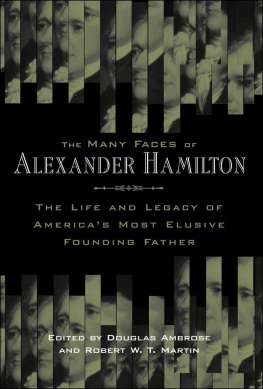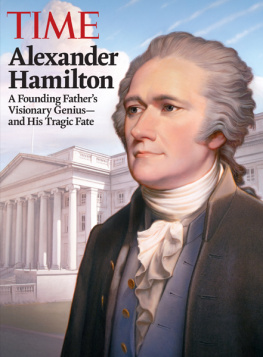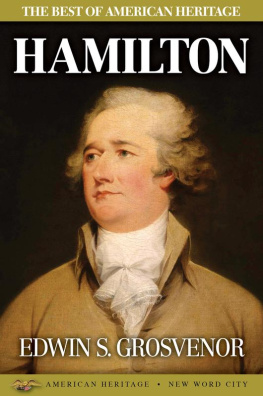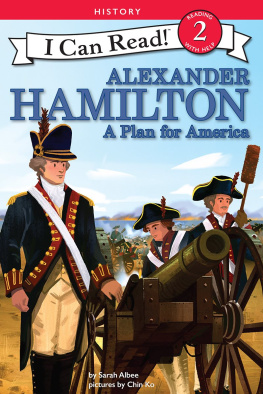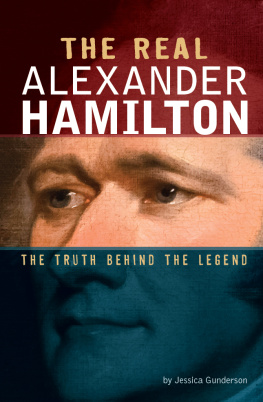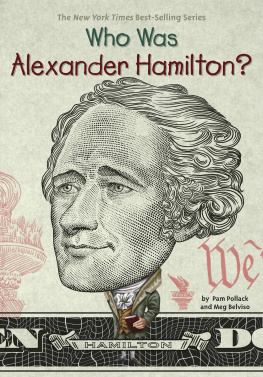Thank you for buying this ebook, published by NYU Press.
Sign up for our e-newsletters to receive information about forthcoming books, special discounts, and more!
Sign Up!
About NYU Press
A publisher of original scholarship since its founding in 1916, New York University Press Produces more than 100 new books each year, with a backlist of 3,000 titles in print. Working across the humanities and social sciences, NYU Press has award-winning lists in sociology, law, cultural and American studies, religion, American history, anthropology, politics, criminology, media and communication, literary studies, and psychology.
The Many Faces of
Alexander Hamilton:
The Life and Legacy
of Americas Most Elusive
Founding Father
DOUGLAS AMBROSE
ROBERT W. T. MARTIN,
Editors
New York University Press
THE MANY FACES OF ALEXANDER HAMILTON
THE MANY FACES OF ALEXANDER HAMILTON
THE LIFE LEGACY OF
AMERICAS MOST Elusive FOUNDING FATHER
Edited by
DOUGLAS AMBROSE ROBERT W. T. MARTIN
N E W Y O R K U N I V E R S I T Y P R E S S
New York and London
www.nyupress.org
2006 by New York University
All rights reserved
Library of Congress Cataloging-in-Publication Data
The many faces of Alexander Hamilton : the life and legacy of Americas
most elusive founding father / edited by Douglas Ambrose and Robert
W. T. Martin.
p. cm.
Includes bibliographical references and index.
ISBN13: 9780814707142 (cloth : alk. paper)
ISBN10: 0814707149 (cloth : alk. paper)
1. Hamilton, Alexander, 17571804Congresses. 2. StatesmanUnited
StatesBiographyCongresses. 3. United StatesPolitics and government
17831809Congresses. I. Ambrose, Douglas, 1957 II. Martin,
Robert W. T. (Robert William Thomas), 1967
E302.6.H2M36 2006
973.4092dc22 2005026120
New York University Press books are printed on acid-free paper,
and their binding materials are chosen for strength and durability.
Manufactured in the United States of America
10 9 8 7 6 5 4 3 2 1
For
Carl Menges
in gratitude
Contents
Acknowledgments
THROUGHOUT his life and especially as the prime mover behind the Federalist Papers, Alexander Hamilton was well aware that publicationunlike the often solitary work of writingis always a collective endeavor that relies on many contributions, great and small. This book is no exception. The most obvious contributions here are those of the scholars who enrich the following pages. We greatly appreciate their careful research, good natures, and, not least, punctuality.
The chapters all began as papers at a working conference at Hamilton College honoring its namesake (and early trustee), Alexander Hamilton. The success of the conference owes much to the contributions and comments of other attending scholars besides our authors. We therefore thank Lance Banning, Richard Brookhiser, Doug Egerton, Eugene Genovese, John Steele Gordon, Graham Hodges, Dan Littlefield, Paul Rahe, and Robert Scigliano. We are also grateful for the conference work of our colleagues Frank Anechiarico, Maurice Isserman, Phil Klinkner, Bob Paquette, and Carl Rubino, as well as Sharon Rippey and Dannelle Parker.
None of these efforts, however, nor even the conference itself, would have been possible without the vision, initiative, and generous support of Carl Menges, a Hamilton College alumnus and Life Trustee, as well as a serious student of American history. We dedicate this book to Carl in honor of his contributions.
The book itself owes a great deal to the encouragement, advice, and support (not to mention patience) of our editor, Debbie Gershenowitz. We also appreciate the work of her colleagues at New York University Press, especially Salwa Jabado and Despina Papazoglou Gimbel. At Hamilton, the book has benefited from the careful eyes of Dawn Woodward and Andrew Graves. And we thank our dean, David Paris, for his support.
We also gratefully acknowledge publishers who agreed to allow previously published works to be included here. A version of Colleen Sheehans essay first appeared in the American Political Science Review 98 (2004): 405424 and is reprinted with the permission of Cambridge University Press. Robert Martins essay first appeared in The Journal of the Early Republic 25 (2005): 2146 (copyright 2005 Society for Historians of the Early American Republic) and is reprinted by permission of the University of Pennsylvania Press.
Finally, we remainas alwaysgrateful for and indebted to the advice, support, and inexplicable forbearance of our long-suffering spouses, Sheila OConnor-Ambrose and Gretchen Herringer.
DOUG AMBROSE
ROB MARTIN
CHAPTER 1
Introduction
The Life and Many Faces of Alexander Hamilton
DOUGLAS AMBROSE
EVERYONE knows the face. It gazes out from the ten-dollar bill, confident, strong, thoughtful. Most Americans know the face of Alexander Hamilton from that ten-dollar bill, and most would probably acknowledge that he rightly occupies a place among the pantheon of those we call the founders. But of all those founders, Hamilton remains the most elusive. For as much as Americans may recognize the face on the bill, few really know the man. And many who think they know him find it hard to embrace him with the same enthusiasm that they do a Washington, a Jefferson, a Madison, an Adams. Hamilton remains both enigmatic and suspect; important, yes, but somewhat tarnished by his supposed lack of idealism, his crass realism regarding economics, finance, military power, and national authority.
Scholars and commentators have not neglected Alexander Hamilton. From before his death in 1804 to the present, historians, political scientists, economists, and others have explored the ways in which Hamilton contributed to the course of American history. And those accounts demonstrate that Hamilton has always functioned as a lightning rod. During his life he embroiled himself in nearly every major political development from the Revolution through the election of 1800. He did so as an active public servant, serving as military officer, delegate to the Constitutional Convention, and first Secretary of the Treasury, and, especially, through his writing. His prolificacy staggers the imagination: at his death at the age of 49 he had produced enough material to fill 27 volumes.
But if Hamilton was a figure who aroused strong feelings among his contemporaries, he has been no less so for scholars. As Stephen Knott demonstrates in his essay in this volume and in his book Alexander Hamilton and the Persistence of Myth, those who have written about Hamilton, like his contemporaries, have provided us with portraits that range from damning to hagiographic. This volume offers a variety of portraits and perspectives that reflect, in part, the persisting enigmatic character of Hamilton. But the essays below also demonstrate that whatever the disagreements about who Hamilton was and what his influence may have been, he remains a central figure in our continuing effort to understand both the founding era and its legacy on subsequent American history. He demands to be studied because his actions, his motives, and his achievements indelibly shaped his world and ours.

